weight Lancia Ypsilon 2020 Owner handbook (in English)
[x] Cancel search | Manufacturer: LANCIA, Model Year: 2020, Model line: Ypsilon, Model: Lancia Ypsilon 2020Pages: 200, PDF Size: 4.53 MB
Page 79 of 200
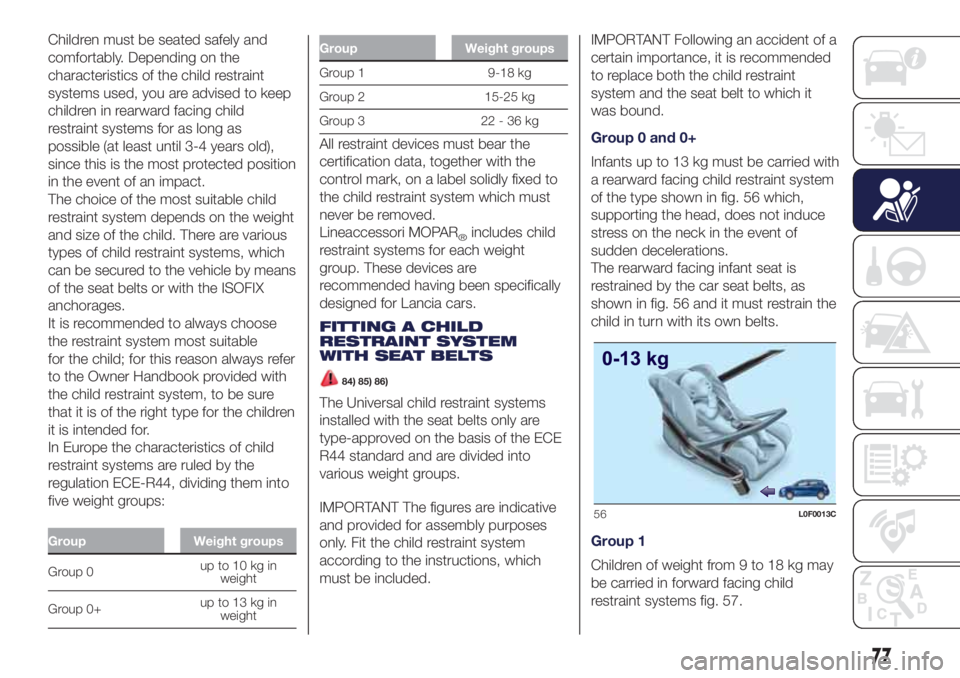
Children must be seated safely and
comfortably. Depending on the
characteristics of the child restraint
systems used, you are advised to keep
children in rearward facing child
restraint systems for as long as
possible (at least until 3-4 years old),
since this is the most protected position
in the event of an impact.
The choice of the most suitable child
restraint system depends on the weight
and size of the child. There are various
types of child restraint systems, which
can be secured to the vehicle by means
of the seat belts or with the ISOFIX
anchorages.
It is recommended to always choose
the restraint system most suitable
for the child; for this reason always refer
to the Owner Handbook provided with
the child restraint system, to be sure
that it is of the right type for the children
it is intended for.
In Europe the characteristics of child
restraint systems are ruled by the
regulation ECE-R44, dividing them into
five weight groups:
Group Weight groups
Group 0up to 10 kg in
weight
Group 0+up to 13 kg in
weight
Group Weight groups
Group 1 9-18 kg
Group 2 15-25 kg
Group 3 22 - 36 kg
All restraint devices must bear the
certification data, together with the
control mark, on a label solidly fixed to
the child restraint system which must
never be removed.
Lineaccessori MOPAR
®includes child
restraint systems for each weight
group. These devices are
recommended having been specifically
designed for Lancia cars.
FITTING A CHILD
RESTRAINT SYSTEM
WITH SEAT BELTS
84) 85) 86)
The Universal child restraint systems
installed with the seat belts only are
type-approved on the basis of the ECE
R44 standard and are divided into
various weight groups.
IMPORTANT The figures are indicative
and provided for assembly purposes
only. Fit the child restraint system
according to the instructions, which
must be included.IMPORTANT Following an accident of a
certain importance, it is recommended
to replace both the child restraint
system and the seat belt to which it
was bound.
Group 0 and 0+
Infants up to 13 kg must be carried with
a rearward facing child restraint system
of the type shown in fig. 56 which,
supporting the head, does not induce
stress on the neck in the event of
sudden decelerations.
The rearward facing infant seat is
restrained by the car seat belts, as
shown in fig. 56 and it must restrain the
child in turn with its own belts.
Group 1
Children of weight from 9 to 18 kg may
be carried in forward facing child
restraint systems fig. 57.
56L0F0013C
77
Page 81 of 200
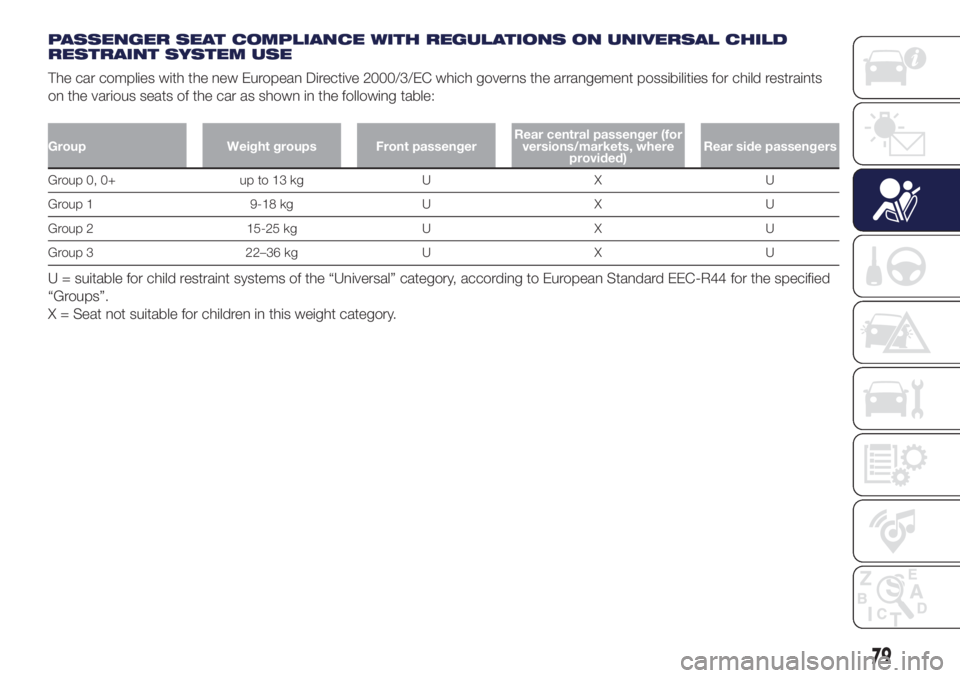
PASSENGER SEAT COMPLIANCE WITH REGULATIONS ON UNIVERSAL CHILD
RESTRAINT SYSTEM USE
The car complies with the new European Directive 2000/3/EC which governs the arrangement possibilities for child restraints
on the various seats of the car as shown in the following table:
Group Weight groups Front passengerRear central passenger (for
versions/markets, where
provided)Rear side passengers
Group 0, 0+ up to 13 kg U X U
Group 1 9-18 kg U X U
Group 2 15-25 kg U X U
Group 3 22–36 kg U X U
U = suitable for child restraint systems of the “Universal” category, according to European Standard EEC-R44 for the specified
“Groups”.
X = Seat not suitable for children in this weight category.
79
Page 82 of 200
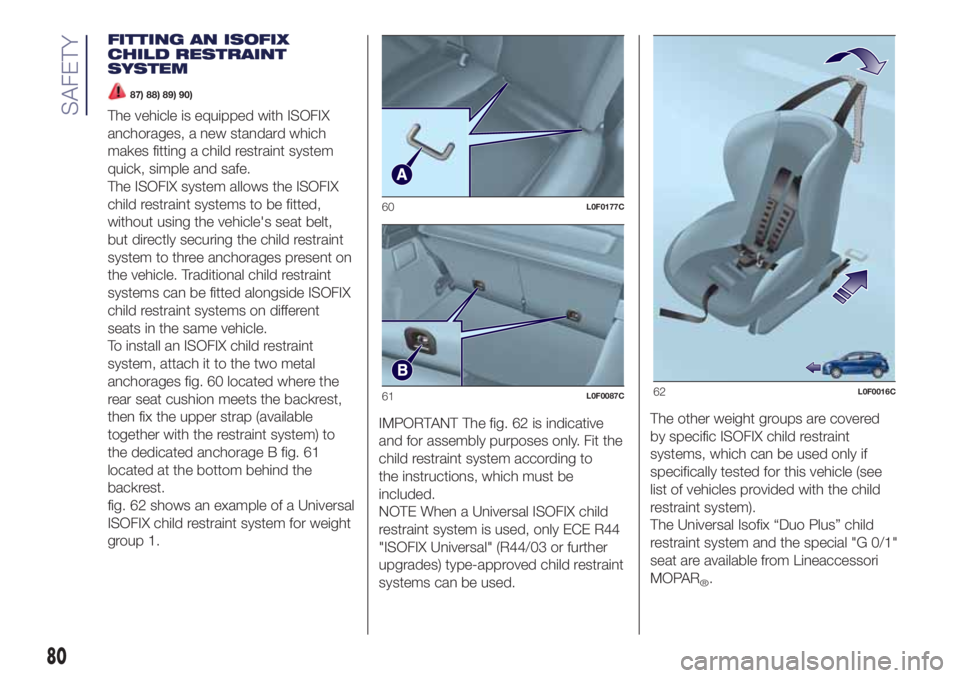
FITTING AN ISOFIX
CHILD RESTRAINT
SYSTEM
87) 88) 89) 90)
The vehicle is equipped with ISOFIX
anchorages, a new standard which
makes fitting a child restraint system
quick, simple and safe.
The ISOFIX system allows the ISOFIX
child restraint systems to be fitted,
without using the vehicle's seat belt,
but directly securing the child restraint
system to three anchorages present on
the vehicle. Traditional child restraint
systems can be fitted alongside ISOFIX
child restraint systems on different
seats in the same vehicle.
To install an ISOFIX child restraint
system, attach it to the two metal
anchorages fig. 60 located where the
rear seat cushion meets the backrest,
then fix the upper strap (available
together with the restraint system) to
the dedicated anchorage B fig. 61
located at the bottom behind the
backrest.
fig. 62 shows an example of a Universal
ISOFIX child restraint system for weight
group 1.IMPORTANT The fig. 62 is indicative
and for assembly purposes only. Fit the
child restraint system according to
the instructions, which must be
included.
NOTE When a Universal ISOFIX child
restraint system is used, only ECE R44
"ISOFIX Universal" (R44/03 or further
upgrades) type-approved child restraint
systems can be used.The other weight groups are covered
by specific ISOFIX child restraint
systems, which can be used only if
specifically tested for this vehicle (see
list of vehicles provided with the child
restraint system).
The Universal Isofix “Duo Plus” child
restraint system and the special "G 0/1"
seat are available from Lineaccessori
MOPAR
®.
60L0F0177C
61L0F0087C62L0F0016C
80
SAFETY
Page 84 of 200

SUITABILITY OF PASSENGER SEATS FOR ISOFIX CHILD RESTRAINT SYSTEM USE
The table below shows the various installation possibilities for Isofix child restraint systems on seats fitted with Isofix
attachments in accordance with European standard ECE 16.
Weight groupChild restraint system
positionIsofix size class Rear passenger
Group 0 up to 10 kg Rear facing EIL (*)
Group 0+ up to 13 kgRear facing E
IL (*)
Rear facing DIL (*)
Rear facing CX
Group1from9upto18kgRear facing D
IL (*)
Rear facing CX
Forward facing BIUF
Forward facing BIIUF
Forward facing TOIUF
IL (*): The Isofix child restraint system can be installed by adjusting the front seat
X: Isofix position not suitable for Isofix retaining system in this weight group and/or size class.
IUF: Suitable for Isofix child restraint systems to be positioned in forward facing position, universal class (fitted with third upper mounting), type-approved for the
relevant weight group.
82
SAFETY
Page 85 of 200
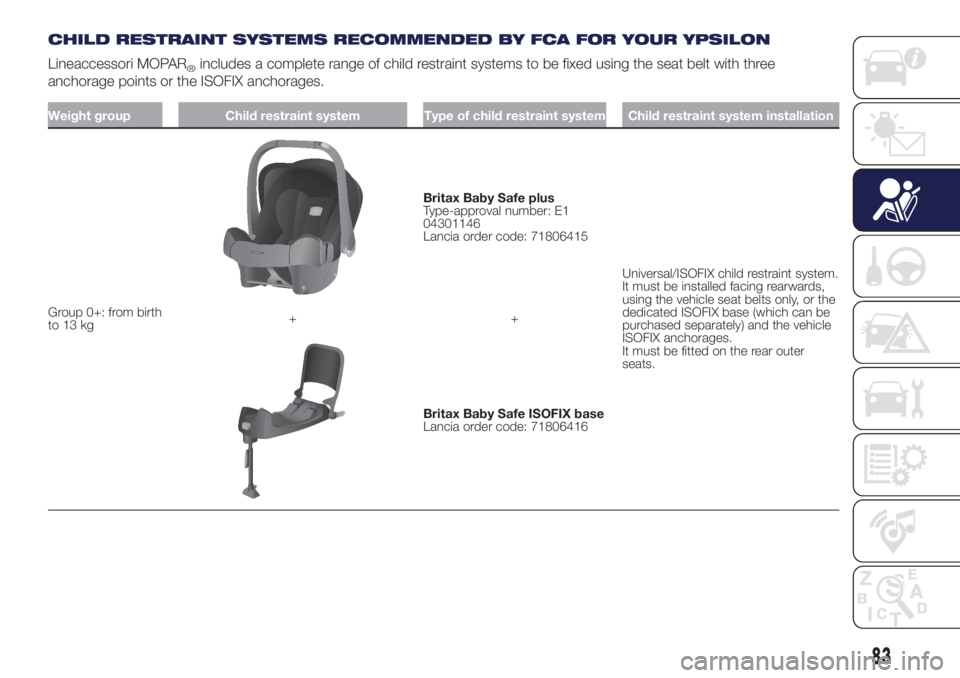
CHILD RESTRAINT SYSTEMS RECOMMENDED BY FCA FOR YOUR YPSILON
Lineaccessori MOPAR
®includes a complete range of child restraint systems to be fixed using the seat belt with three
anchorage points or the ISOFIX anchorages.
Weight group Child restraint system Type of child restraint system Child restraint system installation
Group 0+: from birth
to 13 kg
Britax Baby Safe plus
Type-approval number: E1
04301146
Lancia order code: 71806415
Universal/ISOFIX child restraint system.
It must be installed facing rearwards,
using the vehicle seat belts only, or the
dedicated ISOFIX base (which can be
purchased separately) and the vehicle
ISOFIX anchorages.
It must be fitted on the rear outer
seats. ++
Britax Baby Safe ISOFIX base
Lancia order code: 71806416
83
Page 86 of 200
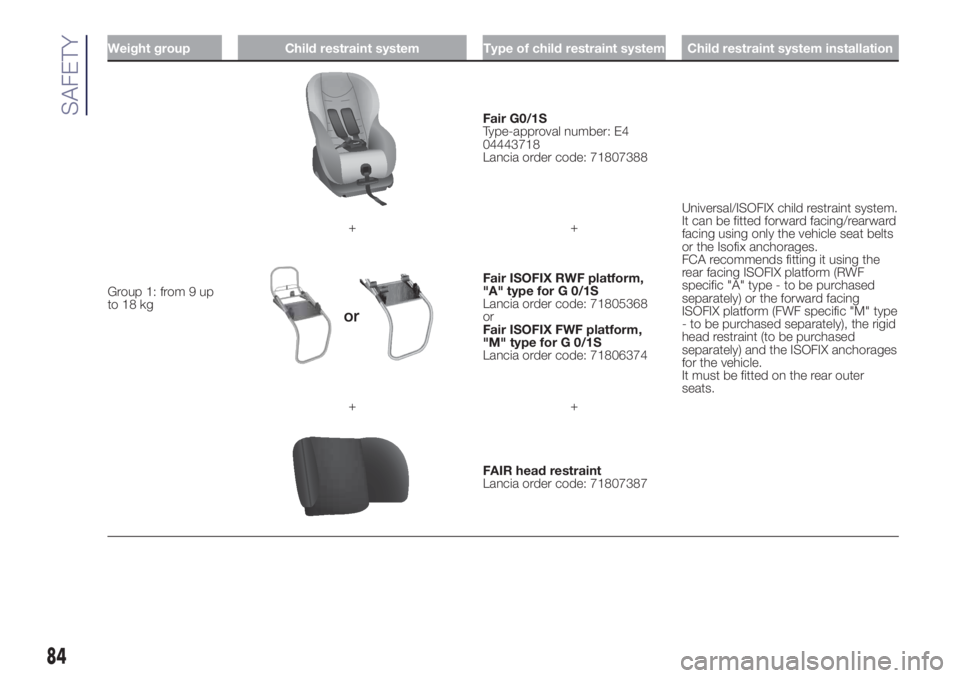
Weight group Child restraint system Type of child restraint system Child restraint system installation
Group 1: from 9 up
to 18 kg
Fair G0/1S
Type-approval number: E4
04443718
Lancia order code: 71807388
Universal/ISOFIX child restraint system.
It can be fitted forward facing/rearward
facing using only the vehicle seat belts
or the Isofix anchorages.
FCA recommends fitting it using the
rear facing ISOFIX platform (RWF
specific "A" type - to be purchased
separately) or the forward facing
ISOFIX platform (FWF specific "M" type
- to be purchased separately), the rigid
head restraint (to be purchased
separately) and the ISOFIX anchorages
for the vehicle.
It must be fitted on the rear outer
seats. ++
Fair ISOFIX RWF platform,
"A" type for G 0/1S
Lancia order code: 71805368
or
Fair ISOFIX FWF platform,
"M" type for G 0/1S
Lancia order code: 71806374
++
FAIR head restraint
Lancia order code: 71807387
84
SAFETY
Page 87 of 200
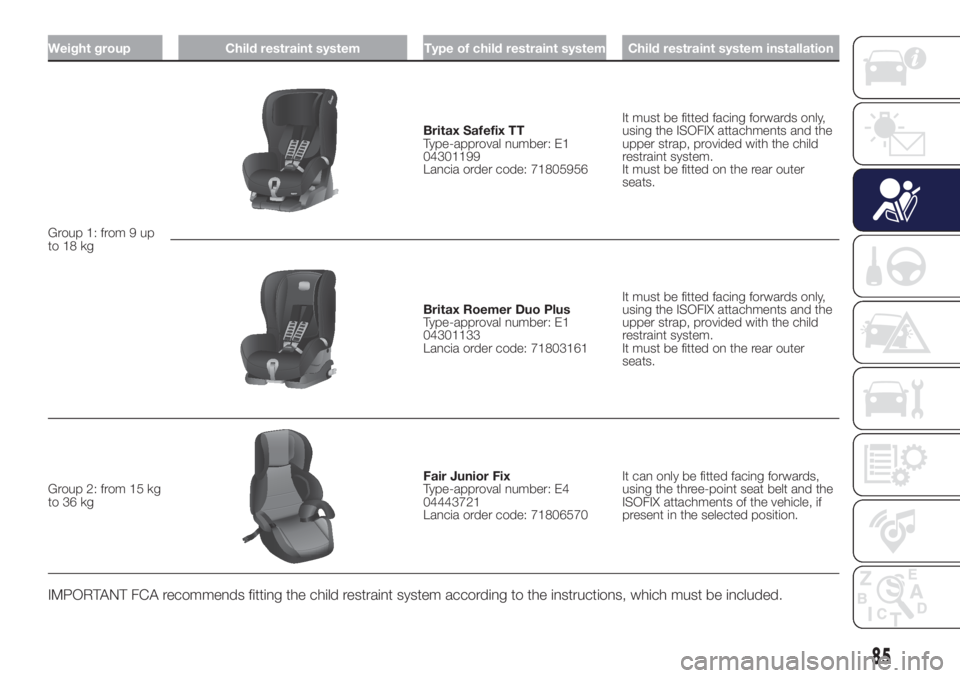
Weight group Child restraint system Type of child restraint system Child restraint system installation
Group 1: from 9 up
to 18 kg
Britax Safefix TT
Type-approval number: E1
04301199
Lancia order code: 71805956It must be fitted facing forwards only,
using the ISOFIX attachments and the
upper strap, provided with the child
restraint system.
It must be fitted on the rear outer
seats.
Britax Roemer Duo Plus
Type-approval number: E1
04301133
Lancia order code: 71803161It must be fitted facing forwards only,
using the ISOFIX attachments and the
upper strap, provided with the child
restraint system.
It must be fitted on the rear outer
seats.
Group 2: from 15 kg
to 36 kg
Fair Junior Fix
Type-approval number: E4
04443721
Lancia order code: 71806570It can only be fitted facing forwards,
using the three-point seat belt and the
ISOFIX attachments of the vehicle, if
present in the selected position.
IMPORTANT FCA recommends fitting the child restraint system according to the instructions, which must be included.
85
Page 104 of 200
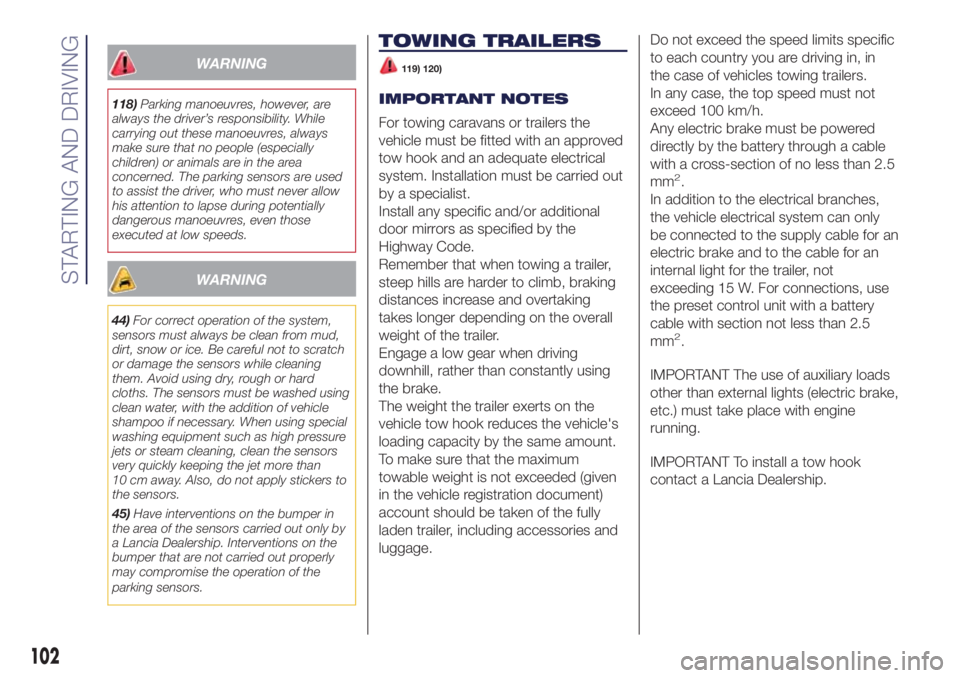
WARNING
118)Parking manoeuvres, however, are
always the driver’s responsibility. While
carrying out these manoeuvres, always
make sure that no people (especially
children) or animals are in the area
concerned. The parking sensors are used
to assist the driver, who must never allow
his attention to lapse during potentially
dangerous manoeuvres, even those
executed at low speeds.
WARNING
44)For correct operation of the system,
sensors must always be clean from mud,
dirt, snow or ice. Be careful not to scratch
or damage the sensors while cleaning
them. Avoid using dry, rough or hard
cloths. The sensors must be washed using
clean water, with the addition of vehicle
shampoo if necessary. When using special
washing equipment such as high pressure
jets or steam cleaning, clean the sensors
very quickly keeping the jet more than
10 cm away. Also, do not apply stickers to
the sensors.
45)Have interventions on the bumper in
the area of the sensors carried out only by
a Lancia Dealership. Interventions on the
bumper that are not carried out properly
may compromise the operation of the
parking sensors.
TOWING TRAILERS
119) 120)
IMPORTANT NOTES
For towing caravans or trailers the
vehicle must be fitted with an approved
tow hook and an adequate electrical
system. Installation must be carried out
by a specialist.
Install any specific and/or additional
door mirrors as specified by the
Highway Code.
Remember that when towing a trailer,
steep hills are harder to climb, braking
distances increase and overtaking
takes longer depending on the overall
weight of the trailer.
Engage a low gear when driving
downhill, rather than constantly using
the brake.
The weight the trailer exerts on the
vehicle tow hook reduces the vehicle's
loading capacity by the same amount.
To make sure that the maximum
towable weight is not exceeded (given
in the vehicle registration document)
account should be taken of the fully
laden trailer, including accessories and
luggage.Do not exceed the speed limits specific
to each country you are driving in, in
the case of vehicles towing trailers.
In any case, the top speed must not
exceed 100 km/h.
Any electric brake must be powered
directly by the battery through a cable
with a cross-section of no less than 2.5
mm
2.
In addition to the electrical branches,
the vehicle electrical system can only
be connected to the supply cable for an
electric brake and to the cable for an
internal light for the trailer, not
exceeding 15 W. For connections, use
the preset control unit with a battery
cable with section not less than 2.5
mm
2.
IMPORTANT The use of auxiliary loads
other than external lights (electric brake,
etc.) must take place with engine
running.
IMPORTANT To install a tow hook
contact a Lancia Dealership.
102
STARTING AND DRIVING
Page 119 of 200
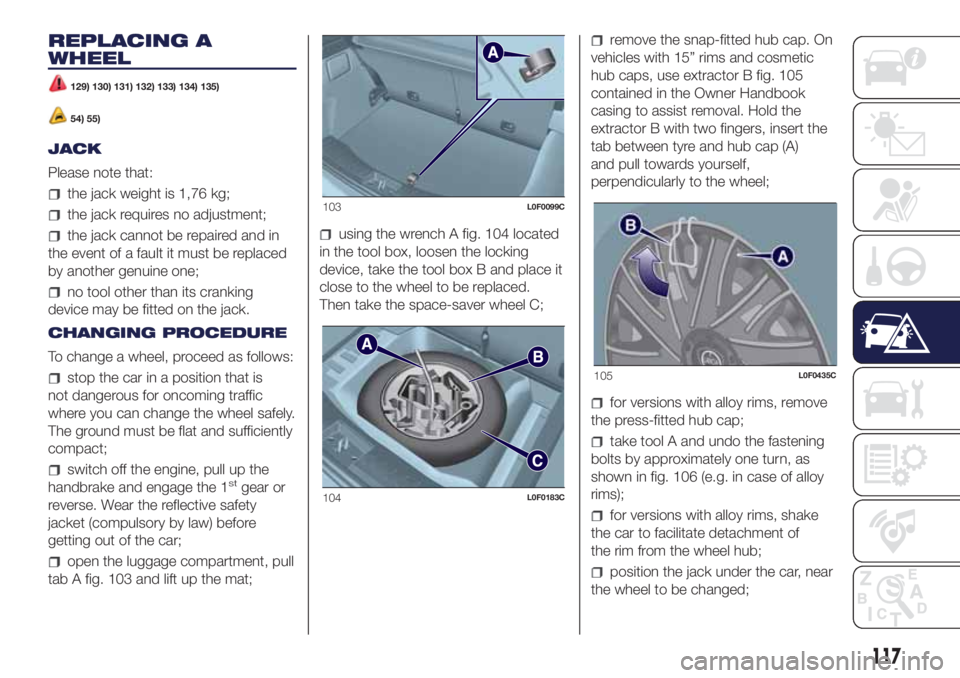
REPLACING A
WHEEL
129) 130) 131) 132) 133) 134) 135)
54) 55)
JACK
Please note that:
the jack weight is 1,76 kg;
the jack requires no adjustment;
the jack cannot be repaired and in
the event of a fault it must be replaced
by another genuine one;
no tool other than its cranking
device may be fitted on the jack.
CHANGING PROCEDURE
To change a wheel, proceed as follows:
stop the car in a position that is
not dangerous for oncoming traffic
where you can change the wheel safely.
The ground must be flat and sufficiently
compact;
switch off the engine, pull up the
handbrake and engage the 1stgear or
reverse. Wear the reflective safety
jacket (compulsory by law) before
getting out of the car;
open the luggage compartment, pull
tab A fig. 103 and lift up the mat;
using the wrench A fig. 104 located
in the tool box, loosen the locking
device, take the tool box B and place it
close to the wheel to be replaced.
Then take the space-saver wheel C;
remove the snap-fitted hub cap. On
vehicles with 15” rims and cosmetic
hub caps, use extractor B fig. 105
contained in the Owner Handbook
casing to assist removal. Hold the
extractor B with two fingers, insert the
tab between tyre and hub cap (A)
and pull towards yourself,
perpendicularly to the wheel;
for versions with alloy rims, remove
the press-fitted hub cap;
take tool A and undo the fastening
bolts by approximately one turn, as
shown in fig. 106 (e.g. in case of alloy
rims);
for versions with alloy rims, shake
the car to facilitate detachment of
the rim from the wheel hub;
position the jack under the car, near
the wheel to be changed;
103L0F0099C
104L0F0183C
105L0F0435C
117
Page 149 of 200
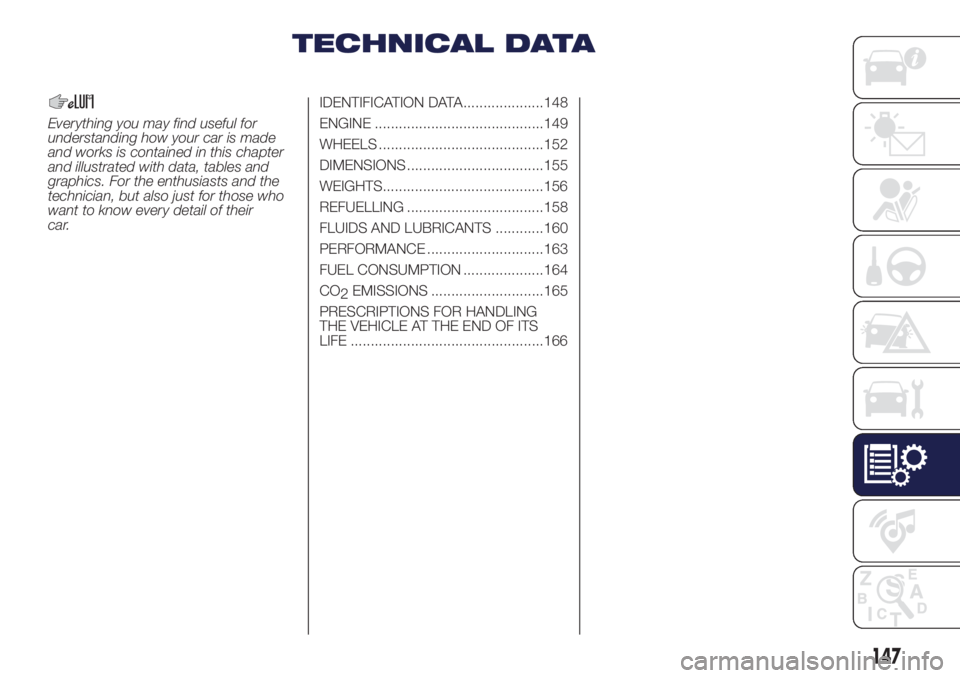
TECHNICAL DATA
Everything you may find useful for
understanding how your car is made
and works is contained in this chapter
and illustrated with data, tables and
graphics. For the enthusiasts and the
technician, but also just for those who
want to know every detail of their
car.IDENTIFICATION DATA....................148
ENGINE ..........................................149
WHEELS .........................................152
DIMENSIONS ..................................155
WEIGHTS........................................156
REFUELLING ..................................158
FLUIDS AND LUBRICANTS ............160
PERFORMANCE .............................163
FUEL CONSUMPTION ....................164
CO
2EMISSIONS ............................165
PRESCRIPTIONS FOR HANDLING
THE VEHICLE AT THE END OF ITS
LIFE ................................................166
147